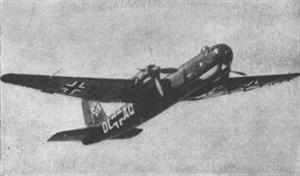Dive Bombers of Luftwaffe
Dive Bombers of Luftwaffe
Dive bombers, the principal German weapon of aggression, played a vital role in the victorious German campaigns of 1939–1941, as the Blitzkrieg doctrine involved close integration of tactical air power and mechanized army units on the ground. The combination of Panzer mobility and Stuka firepower seemed to be unstoppable, and enabled the German ground force to hold the initiative—at least as long as the Luftwaffe possessed air superiority over the battlefield.
A dive bomber was an aircraft that flew nearly vertically at the target in the same direction the bomb would go, released it close to the target at high speed, and then pulled away to safety.
This form of attack, which did not require any sophisticated precision-aiming equipment, could accurately hit a relatively small and/or moving target (e.g., a bridge or a ship) with relative ease, and limited the exposure and effectiveness of enemy anti-aircraft fire. Indeed a dive bomber approached its target in such a way that anti-aircraft fire against it was handicapped.
 The normal level bomber’s straight flight could be predicted by an enemy gunner, the dive bomber on the other hand circled to spot its target and peeled off at an unpredictable angle. When diving, it lost height so rapidly that it could escape anti-aircraft barrage more quickly than a craft flying level. The dive bomber also had a considerable morale effect on ground troops until they got well used to it. The use of dive bomber was thus tactical rather than strategic, operating at the front of the battle rather than against targets deeper in the enemy’s rear. With airplanes growing in speed, strength and load capability in the early 1930s, the valuable technique of dive bombing attracted much attention.
The normal level bomber’s straight flight could be predicted by an enemy gunner, the dive bomber on the other hand circled to spot its target and peeled off at an unpredictable angle. When diving, it lost height so rapidly that it could escape anti-aircraft barrage more quickly than a craft flying level. The dive bomber also had a considerable morale effect on ground troops until they got well used to it. The use of dive bomber was thus tactical rather than strategic, operating at the front of the battle rather than against targets deeper in the enemy’s rear. With airplanes growing in speed, strength and load capability in the early 1930s, the valuable technique of dive bombing attracted much attention.
In Germany in the late 1930s, dive bombing was developed by Ernst Udet who advocated the use of the so-called Sturkampfflugzeug (for short, Stuka—dive bomber) in order to allow the newborn Luftwaffe to operate in a tactical and ground-support role. The dive bomber caused a minor revolution: all the movements of the German land forces were timed, coordinated and planned in conjunction with the air weapon. It could be called up by ground forces in a moment of emergency, and immediately appreciated by the hard-pressed soldier below.
 The dive bomber, however, also produced an obsession with tactical support, resulting in the stipulation of fatal requirements; for example the Junker Ju 88 had to have divebombing capacity, and therefore had to be fitted with heavy air brakes which reduced its performance. It was also idiocy to require of the four-engined Heinkel He 177 that it should dive. Besides, when facing a formidable fighter in opposition, the dive bomber suffered catastrophic losses. After the pendulum of fortune swung back following the battles at Stalingrad and El Alamein, the Luftwaffe no longer had it in its power to dispute Allied superiority in the skies over the German army. After World War II, the dive-bomber class quickly disappeared. One of the reasons was the improvement of anti-aircraft artillery which had become effective against the low-flying and vulnerable dive bomber. At the same time the quality of various computing bombsights allowed for better accuracy from smaller dive angles and could be fitted to almost any airplane.
The dive bomber, however, also produced an obsession with tactical support, resulting in the stipulation of fatal requirements; for example the Junker Ju 88 had to have divebombing capacity, and therefore had to be fitted with heavy air brakes which reduced its performance. It was also idiocy to require of the four-engined Heinkel He 177 that it should dive. Besides, when facing a formidable fighter in opposition, the dive bomber suffered catastrophic losses. After the pendulum of fortune swung back following the battles at Stalingrad and El Alamein, the Luftwaffe no longer had it in its power to dispute Allied superiority in the skies over the German army. After World War II, the dive-bomber class quickly disappeared. One of the reasons was the improvement of anti-aircraft artillery which had become effective against the low-flying and vulnerable dive bomber. At the same time the quality of various computing bombsights allowed for better accuracy from smaller dive angles and could be fitted to almost any airplane.
The most famous World War II German dive bomber was the mass-produced, gull winged, monoplane, two-seat Junkers Ju 87. This airplane became the epitome of Blitzkrieg in the first years of the war, and gained a great reputation because it had freedom to operate without interference or opposition. The Ju 87 was not the only German dive bomber and, of course, other Stukas existed.
